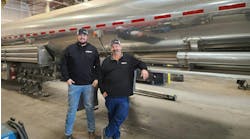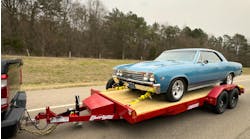Frequency illusion’ is a term that refers to the tendency to see something—new information, names, patterns, my wife’s green Prius—’everywhere’ soon after it’s first brought to your attention. And I’ve noticed lately that ‘supply chain efficiency’ and ‘aftermarket parts’ are being talked about together—and often. And it’s got me to thinking. (Uh-oh.)
I’ve been covering the trucking industry for quite a while, so I’ve sat through more than a few presentations about the evolving supply chain and the critical importance of load visibility—and the impact on fleet operations. Since coming to Trailer/Body BUILDERS, I’ve found that emphasis on load visibility now means smart trailers. But I never experienced an ‘aha’ moment regarding smart trailers.
Quite the contrary: The technology is largely an extension of the telematics systems fleets have been putting on their power units for years and, rather than any sense of epiphany, my reaction to the ongoing push for smart trailers has been more like, ‘no duh.’
Of course trailers need to be extensively tracked. Though the equipment isn’t as complex as a modern tractor, location and weight and tire pressure and reefer temperature still need to be monitored. After all, the trailer is where the payload is.
But what has caught my attention lately—as something new that I suddenly see everywhere—is the critical role aftermarket plays in keeping the supply chain running. Now, those of you in the aftermarket business are likely saying: ‘Kevin, you’re an idiot. What do you think our business is all about?’
My response, even though it’s not much of a defense, would be that I never gave it much thought. That’s even though I’ve written quite a bit about uptime and maintenance schedules and shop processes. And in all those stories, fleets tended to consider parts availability as the problem—one they had little control over—not the solution.
All a trucker knows is what the service counter tells him, and that’s usually bad news. At best, the parts will be in stock—but the customer won’t consider the inventory cost of providing the level of service he expects. Or the part can be sourced locally and delivered in a few hours—again, taken for granted. The only time the customer is going to care about the aftermarket supply chain—and the only thing he’s going to remember—is when he hears: ‘Sorry, you’ve missed our overnight delivery window. It’ll be two days.’
And the pressure has only increased in the age of Amazon and Uber. If my wife can get cat food brought to our front door tomorrow morning, why can’t a trucker get the part he needs just as quickly? I’m not saying that’s a fair analogy, but it’s the reality.
And, more to the point that I should’ve FedEx’d to get it here sooner: What happens when that trucker with the breakdown is carrying the food for my wife’s cat? The problem is no longer a grumpy trucker at the service counter, it’s the transportation boss at Amazon calling the fleet owner to find why his trucks aren’t meeting delivery schedules.
Then I start thinking about what happens when the truck bringing the part to fix the truck bringing the cat food breaks down? Now that trucker is at a service counter wondering where his part is … then my head starts to hurt. It’s a wonder anything gets delivered on time—Zeno’s paradox for the e-commerce age.
That the next-day supply chain works at all ultimately is a testament to transportation equipment and the fleets that run it. You can have all the whiz kids in Silicon Valley writing all the disruptive code they want, but the freight still has to move (at least until we perfect Star Trek’s teleporters and replicators).
Fortunately, lots of smart people in the aftermarket are taking advantage of modern supply chain tools to take out the disadvantages of the relentless push for delivery perfection. This month’s issue features discussions with a range of industry leaders on lessons learned and improvements implemented to keep trucks and trailers moving.
As a teaser (and since I now can’t stop finding aftermarket stories around every corner): Next month’s issue will feature our National Trailer Dealers Association coverage, including an excellent presentation by industry veteran Dave Durand on e-commerce challenges and opportunities for dealerships, and the critical importance of connected systems to reduce the friction in transactions with both suppliers and customers.
So, to all the aftermarket parts suppliers and distributors out there: Thank you for your service (so to speak). I’m sorry I took you for granted. I won’t ever again. Nor will my wife’s cat.









